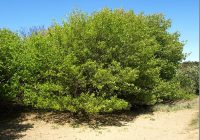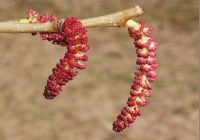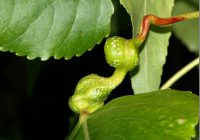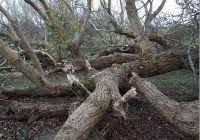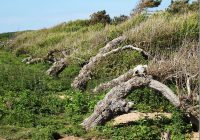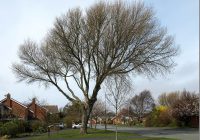The Black Poplar at Formby Point
In October 2008, Patricia Lockwood and I visited the Wirral. While there, by chance, we were shown a large Black Poplar tree in a Hoylake garden. This reminded Pat that her friend, the late Vera Gordon, had recorded a similar specimen at Formby Point many years ago, so we went to see if it was still there. Sue enough, we found the tree near Victoria Road carpark. Unexpectedly, however, it was accompanied by another 83 similar trees in woodland, which Pat christened “Vera’s Grove”. Nearby, stood more of what looked like the same kind of tree around the old asparagus fields.
This was a surprise because the Black Poplar (Populus nigra sub-species betulifolia) is a rare species in Britain, native only in the south and east on river floodplains. National surveys have found only about 7000 individuals and their numbers are declining. This tree has a long history of human use in Britain, its timber having fire resistant and shock absorbent properties. It is the third most common surviving medieval timber after oak and elm, being used especially for crucks and floor-boards. However, these cultural uses are largely defunct and the species has greatly declined in the British landscape. Although not native in northern England, the Black Poplar was widely planted in past
I have been studying the plants of the sand-dunes for many years but had always assumed the Formby Point poplars were hybrids rather than the genuine native Black Poplar. Actually, the differences between the two types of tree are quite subtle, hence the confusion.
Among the main characters of the true Black Poplar are
- A leaning trunk often (but not always) with knobbly bosses.
- Lower branches sweeping down with twigs sweeping upwards at the tips.
- A dense canopy of vivid green leaves
- A yellow exudate around the terminal bud in spring and early summer
- Spiral galls on the leaf stalks produced by an aphid which is hardly ever found on other poplars.
We decided to find out how many Black Poplars there were at Formby Point and map their positions using a hand-held GPS device. The final total was about 650 trees between Cabin Hill in the south and Victoria Road in the north. We also found a few elsewhere along the dune coast, in Formby itself and on roadsides towards Hightown. About 175 hybrid Black Poplars were also recorded within the same area.
This represents a nationally significant number of this rare tree and a population that was previously unknown. It is important to stress that all of them have been planted and they are all male trees, distinguished by the red catkins in spring. Females were rarely planted because they produce copious white fluffy seed which blows around and can be a nuisance.
The question arises, when were they planted and why? Most were found in the following locations:
- Along tracks and paths extending into the dunes.
- On the edges of agricultural fields – mainly old asparagus fields.
- On the borders of, or within, conifer plantations.
Presumably most were planted to provide shelter from strong winds and the blowing sand that was so prevalent in the past, before the dunes became much more stable about 50 years ago. Also, in the 2008 book Sand & sea: Sefton’s Coastal Heritage, Reg & Barbara Yorke refer to the use of poplars, known locally as “Frenchmen”, as nurse trees for pine plantations.
Several Black Poplars were found during our survey along the edges of Corsican Pine plantations in the National Trust estate and also at Ravenmeols, while a much smaller number was noted within the plantations. Most of the original nurse trees must have disappeared long ago, as they were shaded out by the fast-growing conifers.
The question arises, when were they planted and how old are they now? Some of the trees appear really ancient having massive collapsed limbs. Often these have rooted into the ground, sending up new stems that have matured into substantial trees in their own right. Annual ring counts would ideally be used to determine age but this requires specialised equipment and techniques, so we had to use indirect methods as follows:
- Estate history: We know that pine planting began in about 1884 and largely ceased in the 1930s, so the trees that were used as a nurse crop would now be around 75-120 years old.
- Ordnance Survey maps: Early maps, such as the 1893 edition at 25 inches to the mile (surveyed in 1892), show the first plantations as a mixture of conifers and broad-leaved trees. The latter could have included Black Poplars. The maps also indicate rows of broad-leaved trees on field boundaries and track sides. One such, north of Lifeboat Road, appears on the 1893 map and is still there as two lines of heavily weathered Black Poplars with hollow trunks. Their appearance has not changed much in the last 40 years and the trees are probably now over 120 years old.
- Historic and aerial photograph: One photo of Formby Promenade, Ravenmeols, in the FCS archive, taken in 1919 or 1920, shows no trees in front of the promenade. However, a second, taken by R.K. Gresswell in 1933 has a row of trees just west of the promenade. These are still present and are Black Poplars. Assuming they are the same trees, they must now be over 80 years old.
The youngest Black Poplars at Formby Point appear to be those around the National Trust asparagus fields, presumably planted for shelter by the growers. They first appear as small trees on aerial photos taken in 1974. That would make them 40-50 years old.
In summary then, we think the Black Poplars at Formby Point range in age from about 50 to over 120 years.
Despite being a rare tree, these Black Poplars are not of major nature conservation value because they are all planted. However, they are of considerable interest as part of the land-use history of the area and have some landscape value. In ideal conditions, this species lives about 200 years but, growing in impoverished sand in an exposed coastal climate, many of the specimens are in poor condition and some have died within the last few years. Also, several mature roadside trees in Formby have recently been felled. There is therefore concern about their future and Formby Civic Society has investigated the propagation and planting of new stock.
An article, describing the Black Poplar survey and its findings in much more detail, has been published by the Botanical Society of Britain and Ireland in BSBI News 121: 23-34 (2012).

